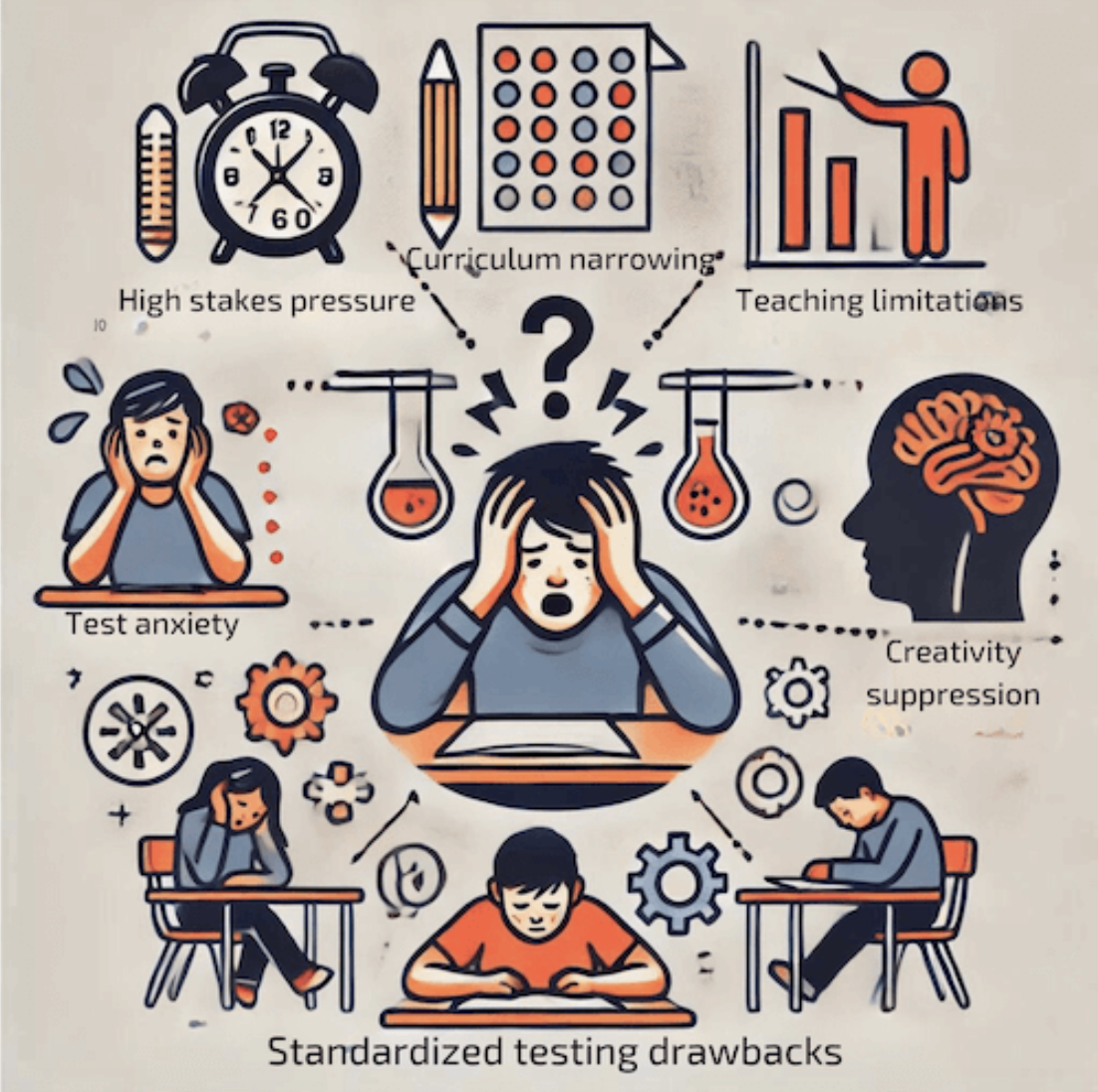The Limitations of Standardized Testing
By: Nick Dong
Evelyn Kim - The Choate News
In recent years, the educational landscape has been dominated by standardized testing as the primary means of assessing student performance. These tests, designed to evaluate knowledge and skills across broad populations, have become synonymous with academic success. However, the over-reliance on standardized testing has sparked significant debate among educators, parents, and policymakers. Critics argue that these assessments offer a narrow view of student abilities, focusing predominantly on memorization and test-taking skills, rather than fostering a deeper understanding of the material or encouraging holistic development.
History of Standardized Testing
by David Horsey | Archive | Email
Standardized testing has long been a part of the educational system, originally conceived as a way to objectively measure student achievement and ensure that educational standards were being met across schools. The intent was to provide a common benchmark that could evaluate the effectiveness of teaching and learning in a consistent manner. Between 1840 and 1875, standardized or formal written tests were implemented so schools could “educate the masses” rather than just “servicing the elite” (NEA). In the 1920s, standardized testing became mainstream across the US, but critics were already pointing out the “memorization and guessing” that these tests encouraged (NEA). Yet, by the 1950s, with the computerization of test scoring and reports, standardized tests like the SAT and ACT were required before reaching college (NEA). In 2001, the No Child Left Behind Act, standardized testing became mandatory to assess school performance. While this approach aimed to improve educational outcomes, it also had unintended consequences.
The Repetitive Nature of Standardized Testing
The drawbacks of standardized testing | Paul Main - Structural Learning
Standardized tests typically emphasize a limited range of skills, primarily focusing on the ability to recall information and apply basic problem-solving techniques. This practice discourages deeper engagement with the material and fails to nurture critical thinking or creativity. As a result, students may become adept at test-taking without truly understanding the underlying concepts, they may even resort to cheating. In addition, “teachers are spending more and more time ‘teaching to the test’” to ensure satisfactory results, rather than teaching or exploring interesting or useful concepts that could help students develop (Armstrong). This practice of strictly preparing students for a test hinders their ability to grow as a student, and only ensures that they pass their current test or grade. Standardized testing has created an artificial learning environment, one that doesn’t support or encourage students to explore interests or engage with content.
Moreover, skills such as creativity, problem-solving, and emotional intelligence are nearly impossible to assess through standardized tests. As a result, creativity is often ignored and students are not encouraged or have the opportunity to pursue such options. These tests are not designed to capture a student’s ability to think outside the box, collaborate effectively, or manage emotions—all of which are vital for success in life outside of school.
The Role of Socio-economic Status
The average combined SAT test score grows with increasing family income | Mark Kantrowitz
Furthermore, standardized tests perpetuate educational inequalities. Students from lower socio-economic backgrounds may not have access to the same test preparation resources as more affluent students, resulting in lower scores that do not accurately reflect their potential. In fact, the “wealthiest 1 percent of Americans were 13 times likelier than the children of low-income families to score 1300 or higher on SAT tests” (Mineo). This is due to both the tutors that wealthier families can afford, but also because those of higher socio-economic status attend better funded schools compared to those in low socio-economi areas (Armstrong). As a result, standardized testing does not provide accurate results which restrict those of lower socio-economic status from opportunities of socio-economic mobility.
Impact on Education
The focus on standardized testing has significantly influenced educational practices, often dictating what is taught and how it is taught in the classroom. Curriculum design tends to prioritize subjects and topics that are likely to appear on the tests, sometimes at the expense of arts, physical education, and other non-tested subjects. This narrow focus can limit the holistic development of students, turning education into a series of boxes to be checked rather than a journey of exploration and growth.
Conclusion
The reliance on standardized testing as the primary measure of student success has long been a cornerstone of the educational system. However, its limitations in accurately reflecting the diverse capabilities and potential of students have become increasingly apparent. It is time to move beyond standardized testing and embrace a more holistic approach to education—one that empowers every student to reach their full potential.
Resources
Armstrong, Thomas. “15 Reasons Why Standardized Tests Are Problematic.” ASCD, 3 Sept. 2013, ascd.org/blogs/15-reasons-why-standardized-tests-are-problematic.
Association, National Education. “History of Standardized Testing in the United States.” NEA, 25 June 2020, www.nea.org/professional-excellence/student-engagement/tools-tips/history-standardized-testing-united-states.
Mineo, Liz. “Wide Gap in SAT/ACT Test Scores between Wealthy, Lower-Income Kids.” Harvard Gazette, 22 Nov. 2023, news.harvard.edu/gazette/story/2023/11/new-study-finds-wide-gap-in-sat-act-test-scores-between-wealthy-lower-income-kids/.



